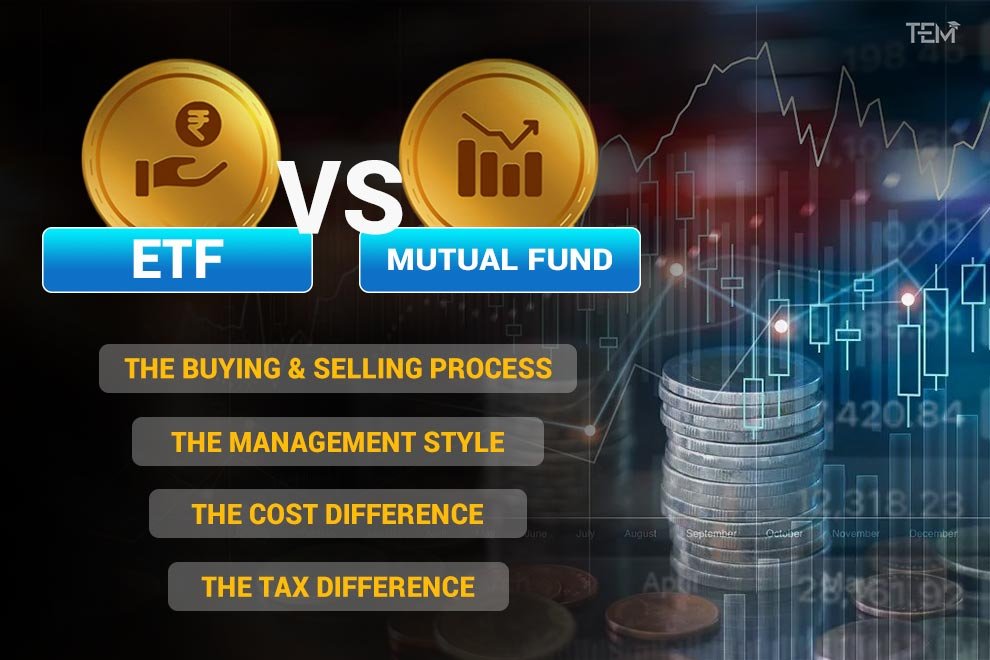You’re ready to invest. Your savings are sitting idle, and you’re eager to put that money to work — but there’s one roadblock: ETF vs Mutual Fund. The terms sound technical, the advice is conflicting, and frankly, it’s overwhelming.
This guide is here to cut through the noise. Whether you’re looking to grow wealth slowly or dive into the market with control, we’ll break down the five core differences that matter — in plain English, without the fluff.
Built on real investor insights and practical experience, this isn’t just theory. It’s a beginner-first guide that respects where you are — and helps you take the next step with confidence.
Let’s make sense of ETF vs Mutual Fund once and for all — starting with the fastest way to compare them: side by side.
ETF vs. Mutual Fund: A Quick Comparison Table
The fastest way to understand the key differences between ETFs and mutual funds is to compare them side-by-side. Here’s a quick table to help you decide which might suit your investment style better:
| Feature | Exchange-Traded Fund (ETF) | Mutual Fund |
| How It Trades | Like a stock, all day on an exchange. | Once per day, at the market close. |
| Typical Cost | Generally, lower expense ratios. | Varies; can be high for actively managed funds. |
| Management Style | Primarily passive (tracking an index). | Varies; can be passive or active. |
| Tax Efficiency | Generally, more tax-efficient in taxable accounts. | Can be less tax-efficient due to capital gains distributions. |
| Minimums | Buy a single share; no minimums. | Often has high initial minimums (e.g., $1,000+). |
| Best For… | The DIY investor, who prioritizes low cost. | The hands-off, long-term retirement saver. |
Point #1: The Buying & Selling Process (Flexibility vs. Discipline)
When comparing ETFs vs Mutual funds, one of the biggest differences lies in how you buy and sell them. And honestly, it’s not just a technical difference—it changes how you behave as an investor.
Let’s start with mutual funds. Buying or selling a mutual fund happens only once per day. No matter when you place the order, the transaction gets executed at the market’s closing price. It’s like catching a scheduled bus that leaves only at 4 PM. You can’t rush it, and you can’t pick the price. But that’s exactly why it works well for long-term investors. It brings discipline. You invest and move on with your day. You don’t get pulled into constant checking or impulsive decisions. It’s ideal for people who want to set a goal, invest regularly, and let time do the work.
Now, compare that to ETFs. These trade all day long on the stock exchange, just like regular stocks. Think of them like taxis—you can grab one anytime. That gives you real-time control. You can respond to market shifts and price movements instantly. But here’s the flip side: it also opens the door to frequent trading, emotional decisions, and trying to time the market—which rarely ends well, especially for beginners.
So in the ETF vs Mutual Fund debate, ask yourself: Do you want steady discipline or real-time control? Your answer tells you which one fits better.
Point #2: The Cost Difference (Expenses and Fees)
When you compare ETF vs Mutual Fund, cost differences become a crucial authority‑building detail. Many mutual funds—especially actively managed ones—charge higher expense ratios that typically range between 0.50% and 0.75% per year. These fees cover portfolio managers, research, and sometimes marketing costs (like 12b‑1 fees).
Yet not all mutual funds cost a lot. Some index mutual funds charge as little as 0.50%, and investors increasingly favor these low‑cost options over higher‑fee rivals. That nuance is key to expert-level credibility.
Now look at ETFs—they tend to be passive and track indexes. The average expense ratio for index equity ETFs stands at about 0.14% in 2024, while active ETFs average around 0.48%. In short, ETFs often cost half (or less) compared to mutual funds.
But wait—cost comparisons must also include trading charges. ETFs trade like stocks, so brokers may charge commissions, bid‑ask spreads, SEC transaction fees, and local taxes. In India, brokerage can run around 0.01% of turnover, plus a 0.1% Securities Transaction Tax (STT) and GST on fees. Mutual funds, especially direct plans, typically come commission‑free in India.
Thus, when considering ETF vs Mutual Fund, look beyond expense ratios. Include trading costs, fund type, and whether you prefer paying for expert management or favour a simpler, low‑cost structure.
Point #3: The Management Style (Is an Expert Necessary?)
Ever wondered what really happens behind the scenes of your investment? That’s where the ETF vs Mutual Fund comparison gets interesting — not in what you invest in, but who makes the decisions.
Let’s break it down. Active management means there’s a fund manager — a real person — making calls on which stocks to buy or sell. Their goal? To beat the market. It’s like trusting a chef to create a custom dish based on what they believe will taste best today. Most mutual funds use this style. But that also means higher fees and a constant chase to outperform, which doesn’t always succeed.
Now flip the coin. Passive management doesn’t try to outsmart the market. It just follows it. The fund simply mirrors a specific index like the S&P 500 or Nifty 50. This is what most ETFs do. No active picking. No daily decisions. Just a rules-based approach that aims to capture market returns with minimal cost.
So here’s the real fork in the road: Do you believe someone can regularly pick winners and beat the market? Or do you believe markets, over time, reward patience and consistency? For most beginners, the passive route is not only cheaper — it’s easier to stick with.
In short, your view on ETF vs Mutual Fund may come down to one thing: human judgment versus market logic.
Point #4: The Minimum Investment (Getting Started is Key)
When you’re just starting your investment journey, the first question is often simple: How much do I need to get started? That’s where the ETF vs Mutual Fund difference feels the most real—especially if you’re working with a small budget.
Traditionally, mutual funds came with a minimum investment requirement. Many still ask for $1,000 or more to begin. That can be a big ask if you’re just starting out or testing the waters. For some investors, this becomes a mental and financial barrier. You wait longer, you save more, and sometimes, you lose momentum.
In contrast, ETFs are more flexible. You can start with the price of a single share. If an ETF is trading at $50, you can begin with exactly that. No extra forms, no special rules. This accessibility has made ETFs a favorite for new and younger investors.
But here’s the modern twist. Many platforms today offer fractional shares. This means you don’t need to buy a full share of either ETFs or mutual funds. You can invest $5 or $50, regardless of the asset price. Also, if you’re investing through a 401(k) or employer plan, mutual fund minimums often don’t apply at all.
So while the ETF vs Mutual Fund gap in minimums used to be clear-cut, technology has closed that gap. Today, the real difference isn’t about how much you need—but how easily and confidently you can begin.
Point #5: The Tax Difference (For Non-Retirement Accounts)
In the ETF vs Mutual Fund comparison, the way they handle taxes can significantly affect your returns—especially outside retirement accounts.
A mutual fund must distribute capital gains to investors whenever the manager sells holdings inside the fund. That means you may owe tax even if you don’t sell your own shares. In many years, 30% or more of mutual funds distribute capital gains, sometimes equal to 5–8% of the fund’s net asset value (NAV).
In contrast, ETFs generally distribute far fewer capital gains. In 2023, only 2.5% of ETFs paid capital gains, versus 31.5% of mutual funds. Structurally, ETFs use in-kind redemption with authorized participants to limit in-fund sales—and thus reduce taxable events for investors. Studies show that passive ETFs average capital gains distributions of 0.78%, while active mutual funds distribute nearly 5.35% of NAV on average.
Beginner Takeaway: If you hold investments in a retirement account like a 401(k) or IRA, this point doesn’t apply—those accounts are tax-advantaged. But in a taxable brokerage account, ETFs often let you defer taxable gains until you sell. Meanwhile, mutual fund investors may pay tax each year—even without selling.
So, in the ETF vs Mutual Fund tax difference, ETFs position themselves as more tax-efficient in taxable accounts. That makes them a smart choice for investors who care about keeping more of their gains in the long run.
Point #6: The Best Fit for Different Types of Investors (Who Should Choose What?)
By now, the key differences between ETF vs Mutual Fund are clear. But here’s the real question: Which one fits you better? Because investing isn’t just about picking the “best” product — it’s about choosing what works for your habits, goals, and comfort level.
Let’s start with mutual funds. These are ideal if you prefer a hands-off, long-term approach. Maybe you don’t want to think about the stock market every day. You just want to invest, automate it, and let it grow. Mutual funds — especially when used in retirement plans like 401(k)s or SIPs — are designed for exactly that. They’re structured, professionally managed, and built for the long run. If you like routine and simplicity, this route might suit you better.
Now take ETFs. These are for investors who like flexibility and control. Want to buy at 11:15 AM and sell at 2:45 PM? You can. Want to invest in niche sectors or themes? There’s probably an ETF for that. ETFs work best in taxable brokerage accounts, where their low fees and tax efficiency shine. And if you’re cost-conscious or follow a DIY investing style, they offer transparency and ease with every trade.
So in the ETF vs Mutual Fund conversation, it comes down to this: Are you someone who values structure and simplicity? Or do you prefer control and flexibility? There’s no wrong answer — just the right fit for you.
Key Takeaways
When you strip away the noise, ETF vs Mutual Fund isn’t just a financial comparison — it’s a mindset shift. ETFs offer flexibility, low fees, and tax efficiency, which appeals to self-driven investors who prefer more control. Mutual Funds, on the other hand, come with a built-in management layer — ideal for those who want investing handled for them.
But here’s the core of it: what are you solving for?
If the goal is simplicity, automation, and long-term stability, Mutual Funds often fit the bill. If you’re more hands-on, want to tweak your portfolio, or minimize costs over time, ETFs are likely the better fit.
The “better” option depends not just on the numbers, but on your behavior, time, and comfort with risk.
Also, don’t ignore the environment you’re investing in — taxable account or retirement? Active trader or passive grower? These seemingly small choices shape the long-term outcome.
The key is clarity. Once you’re clear about how you want to grow your wealth, the right option almost picks itself.
Because in the end, it’s not about ETFs vs Mutual Funds. It’s about you vs indecision.
Choose clarity. Then choose your investment.
Also Read: FAFSA 2025-26: Secure Your College Funding









